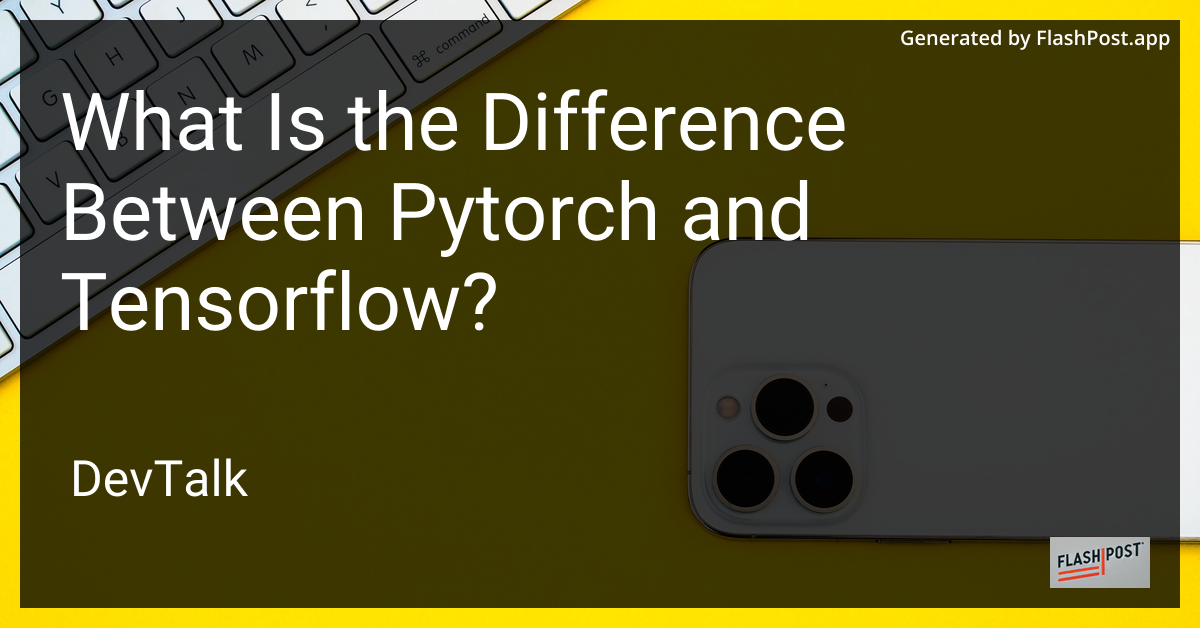What Is the Difference Between Pytorch and Tensorflow?

What is the Difference Between PyTorch and TensorFlow?
In the realm of deep learning, two major frameworks are especially prominent: PyTorch and TensorFlow.
Both have their unique strengths and have fostered active communities, but they also exhibit fundamental differences that cater to different kinds of projects and users. In this article, we'll explore these differences, helping you decide which one might be the best fit for your needs.
Overview of PyTorch
PyTorch is an open-source machine learning library developed by Facebook's AI Research lab (FAIR). It has quickly gained popularity due to its dynamic computational graph and intuitive interface. This dynamic nature makes it particularly appealing for researchers who need flexibility in experimenting with models. PyTorch is well-suited for tasks that require real-time performance, making it a preferred choice for many in academia.
Key Features of PyTorch:
- Dynamic Computational Graphs: PyTorch allows for changes during runtime, making debugging and development more straightforward.
- Pythonic Nature: Those familiar with Python will find PyTorch's interface intuitive and easy to integrate with other Python libraries.
- Strong GPU Support: Built-in support for CUDA makes PyTorch especially efficient for GPU acceleration. For further information on applying CUDA to custom models, visit PyTorch CUDA Application.
Overview of TensorFlow
Developed by Google Brain, TensorFlow is another open-source library for machine learning. It gained traction early on in the industry for its robust capabilities in deploying models to production. TensorFlow offers both high-level APIs (like Keras) and low-level functionalities for more in-depth customization, giving it a broad appeal.
Key Features of TensorFlow:
- Static Computational Graphs: TensorFlow constructs the computation graph beforehand, which can lead to optimizations in distributed settings.
- Production-Ready Deployment: TensorFlow’s Serving tool and TensorFlow Lite make deploying models across various platforms seamless.
- Versatile: TensorFlow encompasses a wide range of machine learning and deep learning algorithms, making it a comprehensive framework.
Differences Between PyTorch and TensorFlow
-
Computational Graphs:
- PyTorch: Offers dynamic graph creation, which can be modified on-the-fly.
- TensorFlow: Uses static graphs, leading to potential optimizations but less flexibility during runtime.
-
Ease of Use:
- PyTorch: Known for being more intuitive and easy to use, particularly for Python users.
- TensorFlow: Has a steeper learning curve but offers detailed APIs for complex tasks.
-
Community and Support:
- PyTorch: Popular among researchers and academic communities.
- TensorFlow: Enjoys widespread use in industry and is backed by Google’s extensive resources.
-
Deployment:
- TensorFlow tends to have the edge in deployment tools and production-ready models, while PyTorch continues to gain ground with tools like TorchServe.
Use Cases in PyTorch
The flexibility and user-friendly nature of PyTorch make it ideal for research and experimentation. For instance, researchers focusing on dynamic tasks where model constraints need adjustment can benefit from resources like How to Constrain the Output of a Layer in PyTorch. Additionally, for projects that require deep analysis into parameter significance, you might find this guide on Computing the Parameter Importance in PyTorch insightful.
Conclusion
Both PyTorch and TensorFlow have their pros and cons, making each suitable for different types of projects and users. If flexibility and ease of use are your primary concerns, especially during the research and development phase, PyTorch is likely the better choice. On the other hand, if you're looking for a library that offers extensive tools for deploying models in production settings, TensorFlow might be more suitable. Ultimately, your specific requirements and workflows should guide your choice between these two powerful deep learning frameworks.